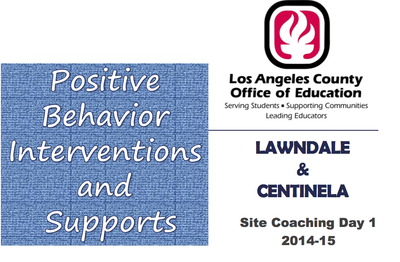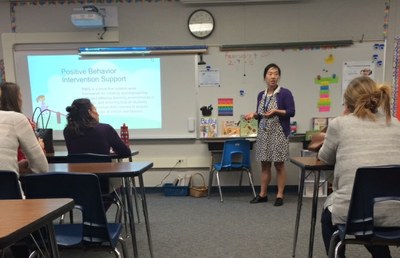PBIS Project: Teacher Leader
Project Rationale

LESD has been transitioning to implement the Positive Behavioral Intervention and Supports (PBIS) program in all of its schools. The zero tolerance systems of the past have often criminalized students, specifically students who have already been marginalized by their race, gender and socio-economic status. PBIS program refocuses schools to build a safe environment with emphasis on the root issue of students’ social and emotional needs rather than taking the zero tolerance approach. The objective of my project at my site was to attend training and assist the administrator in the implementation of PBIS program during the school year. In the first true year of the implementation, my project aimed to inform stakeholders (teachers, families and students), lead discussions regarding the PBIS program as it pertains to our site, and take our school to the next step in the PBIS implementation steps.
Leadership Activities
 My leadership role was, first, to understand the PBIS systems. I attended trainings and learned about the PBIS program from experts at the Los Angeles County Office of Education. My first official training was on January 8, 2015. At this Coaching day, I received a quick overview of PBIS, reviewed what has been working and what we need to improve on, and also learned about how other schools in the neighboring areas have implemented PBIS. After the January meeting, the PBIS team at my school (principal, behavior specialist, Language Arts specialist, social worker and myself) prepared for a staff meeting. We also discussed where we felt that our site was in terms of the implementation process. In the staff meeting we gave a brief refresher to teachers explaining PBIS, participated in some team building activities and lastly, asked teachers to think of specific behavior matrixes for the school. I gathered the input and organized it into a readable format for the leadership team to discuss. PBIS Staff Development PPT
My leadership role was, first, to understand the PBIS systems. I attended trainings and learned about the PBIS program from experts at the Los Angeles County Office of Education. My first official training was on January 8, 2015. At this Coaching day, I received a quick overview of PBIS, reviewed what has been working and what we need to improve on, and also learned about how other schools in the neighboring areas have implemented PBIS. After the January meeting, the PBIS team at my school (principal, behavior specialist, Language Arts specialist, social worker and myself) prepared for a staff meeting. We also discussed where we felt that our site was in terms of the implementation process. In the staff meeting we gave a brief refresher to teachers explaining PBIS, participated in some team building activities and lastly, asked teachers to think of specific behavior matrixes for the school. I gathered the input and organized it into a readable format for the leadership team to discuss. PBIS Staff Development PPT
The PBIS team has made many attempts at implementing PBIS at our site. We attempted to begin a positive behavior reward system. We also began a form of “mentoring” program at our school with the leadership of our administrator. Each teacher signed up with an at-risk student to build rapport and positive relationships within school. Although we do not have any data, yet, on how these mentorships have made an impact, the positive affects of these relationships are observable in the faces of staff and students. Our PBIS team has more room for growth in the coming years to make PBIS a system-wide program within our school. The second Coaching day on April 14, 2015 was informative for our next steps. We learned that it is crucial to look at school data more closely next year to better guide our implementation.
When I first began the project, I was not aware of how long of a commitment it would take for all stakeholders to make a paradigm shift in thinking and in behavior. This year, the PBIS project was still developing its seed coat at our school and I believe that it will blossom into full implementation in the coming years.
CAPEs Connection
My activities in implementing the PBIS program at my school connects to the following CAPEs:
CAPE 1 (Developing and Articulating a Vision of Teaching and Learning Consistent with LEA’s Vision): By attending coaching sessions and by implementing PBIS as a school, I have, with the help of the PBIS team, attempted to guide the school toward a vision of working with school community to modify and encourage positive behaviors and responses.
CAPE 2 (Developing Shared Commitment to Vision): The PBIS team and I have worked in collaboration to develop a commitment to PBIS implementation. The behavior specialist, social worker, teachers, office staff as well as the principal are all a part of this team. Time and space is allotted to PBIS discussion during staff meetings for all staff members to build a sense of responsibility for PBIS within the community.
CAPE 3 (Leading by Example to Promote Implementation): In terms of equity and issues related to race, diversity and access, PBIS implementation has allowed me to talk to staff about the inequity occurring in student suspension rates and how this is often related to race, diversity and future access to education. We have had honest discussions about PBIS as a result.
CAPE 8 (Communicating With the School Community about Outcomes Data and
Improvement Goals): With respect to communication, I have used staff meetings to communicate with staff regarding PBIS. First, I used a staff meeting to inform staff about PBIS and its definitions. The team, then, used time during meetings to talk about different aspects of how positive behavior slips as well as mentoring systems would be used to increase positive student behavior.
CAPE 10 (Implementing Change Strategies Based on Current, Relevant Theories and Best Practices in School Improvement): The PBIS implementation process has informed my practice as a school leader. PBIS is based on research and best practices, departing from the zero tolerance type of discipline systems of past practices. Through this project, I have gained knowledge about PBIS and the various resources that I can utilize to implement this process. By informing staff members and learning about PBIS and its affects on our school site, I have attempted to improve the school growth plan by promoting a positive, student and family friendly way to work with student behavior.

Reflection
My role as a PBIS implementation team member included mostly training. I knew from the beginning of the year that I would have to learn all the basics of PBIS. That was a challenge in itself because many of my team members had already been trained and I felt a need to catch up. A challenge in the process did not come from PBIS, itself, but from a lack of substitutes in the district. I was not able to attend a few of the trainings and it affected the momentum of the implementation process for me. Another challenge was the fact that many of our staff members were new to our district and had not had exposure to the PBIS system. This made it a priority for our team to go over basics of PBIS as we implemented the system. While going over basics of PBIS, I had great one-on-one discussions with other staff members about theories and strategies that help us see our students more equitably. It provided meaningful opportunities for professional and personal growth. Although I had hoped to implement more parts of PBIS by the end of the year, I realized that I cannot hurry this process. In addition, my lack of knowledge regarding PBIS at the beginning of the year frustrated me. I felt that I had a larger learning curve to overcome and I was concerned that I was slowing down the implementation process for my team. However, I learned that an implementation of a large-scale program such as PBIS requires a lot of preparation, discussion and modification as it becomes implemented. This process tested my patience with myself and taught me that learning sometimes is a slow process, but well worth the wait.
Supporting Documents
PBIS Matrixes for Various Areas in School/Results from Staff Development


